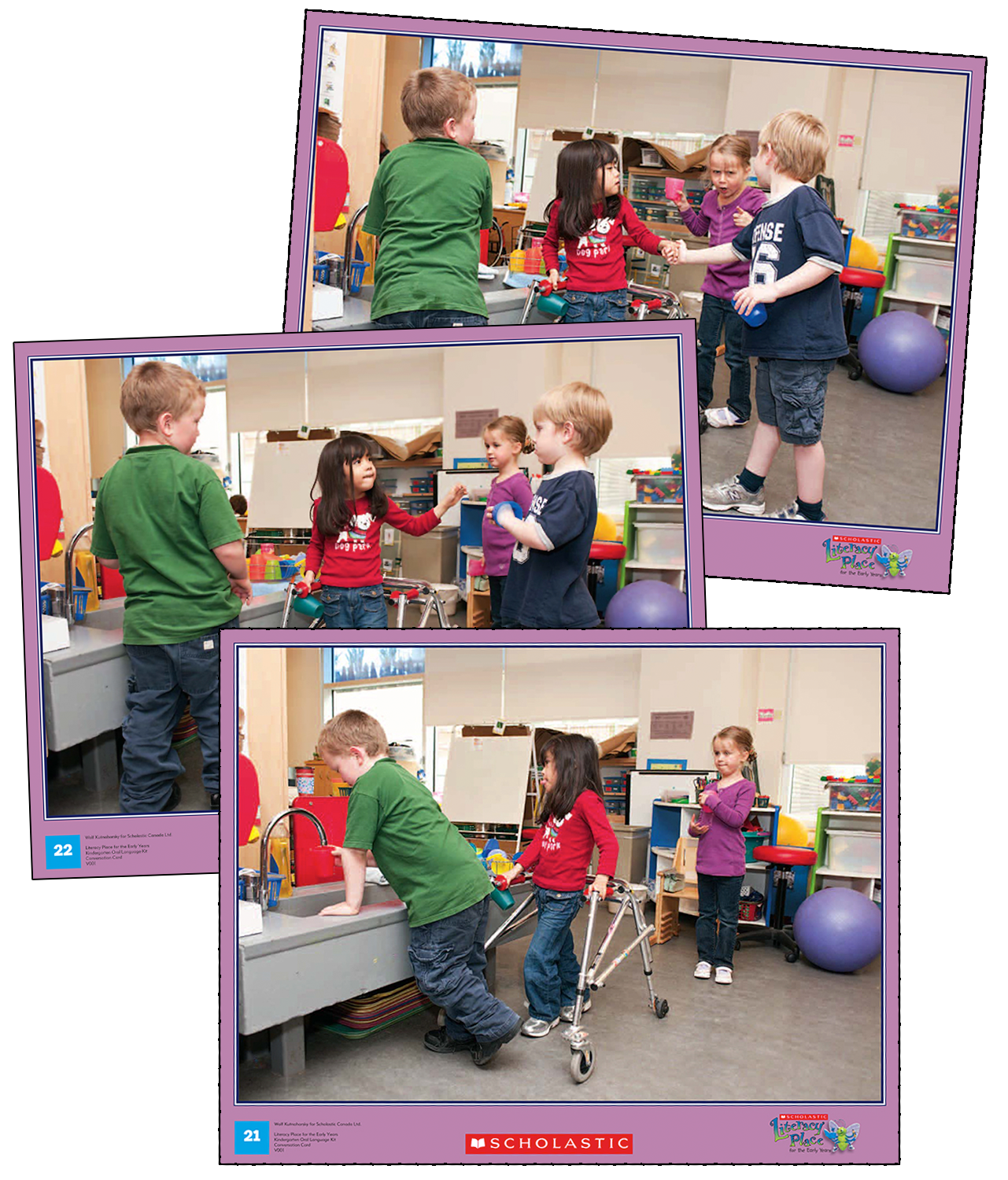Summary: These three cards depict three children waiting in line to get a drink. One child invites another to ‘butt’ into the line. The other children don’t appreciate this breaking of the rules.
Oral Language Teaching Strategy: Disagree Agreeably Help students cope with disagreements in social settings by showing them how they can disagree in discussions.
Time: one 30-minute lesson or two 15-minute lessons
Materials: Sequence Cards #21, 22, 23
Grouping: whole class or small group
Assessment:
Kindergarten Oral Language Assessment Scale
FOCUSING ON THE PICTURE
[Analyzing/inferring]- Show one of the sequence cards and have students share what they think is happening in the picture.
- Invite each student to share their ideas about the picture with a partner.
- Provide time for partner discussion and then invite a few partners to share their thinking with the group.
- Offer prompts to stimulate discussion:
- Who are the people in this picture?
- Where do you think they are? What clues in the photograph make
you think that way? With your partner talk about what you think is happening in this photograph.
What do you think is happening? Why do you think that? We don’t know exactly what is happening, but it’s okay to suggest different things that make sense and fit with the picture.
GOING DEEPER
- Display a second sequence card.
- Ask students to turn and talk to a partner about how this photograph adds to their understanding of the previous photograph.
I have two pictures here but I can’t figure out which one comes first and which comes second. What do you think?
- Have students share their thinking with the group.
- As a group, decide the order of the two cards and have students share their reasoning.
- Encourage student responses such as:
- I think that the boy is getting a drink and the other kids are waiting.
-
Good observation, Jackson. We don’t allow butting in our classroom. What would you do if someone butted in line?
The next picture shows another boy coming to get a drink. - But she’s letting him butt in, and we don’t do that in our class.
- I think that the picture with three kids comes first, because there are fewer kids than in the second picture.
- Invite four students to role play the actions in one of the sequence cards, followed by another group of four students acting out the actions in the other sequence card.
-
Sasha, you think the picture with 3 children comes first, but Georgia thinks the picture with 4 children comes first because one of the boys had his drink and left and then 3 kids are still there. That’s a good observation, Georgia. Good thinking!
Discuss how students can disagree with one another’s understanding of what might be happening in the photographs.
You may conclude the lesson at this point and do the second part on the next day, or you may decide to continue and do Connecting and Predicting as part of the first lesson.
CONNECTING
Teaching Tip: If you decide to do Connecting and Predicting on the second day, begin your lesson by reviewing the two sequence cards you have already shared with the students.
[Making connections]- Ask students to connect their personal experiences with the emotions and interactions in the pictures. Prompts might include:
- What are some of the rules we have in our classroom about waiting our turn?
- How do you feel when someone doesn’t follow these rules?
- How do you think your classmates feel when you don’t follow the rules?
- Why do you think we have these rules in our classroom?
- Is it important that we follow these rules all the time?
- What can we do when others don’t follow the rules?
- Should we ever change our rules?
-
What might you say to someone who isn’t following the rules?
Offer specific prompts that fit the discussion you have had with the group
PREDICTING
[Predicting]-
What do you think happens first? What happens next? Why do you think this?
Provide students with the remaining sequence card. Invite students to take turns placing the three cards in an order that makes sense to them and to share their reasoning with the group. How would you solve this problem of butting in?
Continue the discussion by having students understand that there are many sides to a situation and that it is important to hear all sides of a story. Emphasize that it’s okay to disagree with the decision made by others but students need to understand that there are other considerations to keep in mind when making choices.
LESSON EXTENSIONS
- Use the sequence cards as the basis of a shared writing lesson, by having the students list:
- different situations from their classroom that are similar to those represented in the sequence cards, such as taking turns at the sandbox and waiting in line for gym equipment
- ways that they can work together solving problems, such as taking turns, being a friend, using good manners, and following directions.
- Use the shared writing text as a shared reading text and reread with the students.
- Place the shared writing text in an area where students can refer to it during centre time.
FOLLOW-UP IN CENTRES
- Provide students with a variety of puppets and Sequence Cards #21, 22, and 23. Students can retell the story as they practise their problem solving skills for situations like the ones depicted.
- In a dress-up centre, have students role play different situations where they must solve problems using the ideas from the class discussion.
- Provide students with blank pieces of paper and drawing tools for them to create their own set of sequence cards or to replicate the sequence cards in this lesson.

